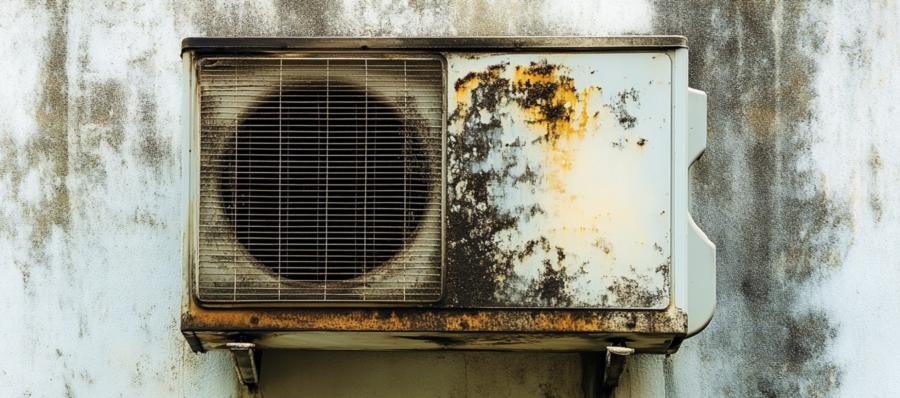Silent Spreaders: How Your HVAC System Might Be Blasting Mold Spores Into Your Home

The Unseen Menace Lurking in Your Vents
Mold is sneaky. It doesn’t march in through the front door, waving a banner. It seeps, it creeps, and, worst of all, it hides. Many homeowners focus on scrubbing the visible offenders—bathroom tiles, basement walls, that suspicious patch behind the fridge. But the real troublemaker might be something you never think about: your HVAC system.
Yes, that same system responsible for delivering cool, refreshing air in the summer and cozy warmth in the winter could be playing the role of a fungal mailman, distributing mold spores to every room like an overenthusiastic coupon flyer distributor. And the worst part? You might not even realize it’s happening.
How Your HVAC System Becomes a Mold Wonderland
Mold needs three things to thrive: moisture, warmth, and organic material. Now, let’s do some quick HVAC math.
- Moisture? Check. Your air conditioning coils and condensation pans are practically a spa for mold.
- Warmth? Oh, absolutely. If you’ve ever been near an active furnace, you know it’s cozy in there.
- Organic material? Dust, dirt, and even microscopic debris make for an all-you-can-eat buffet.
Over time, mold spores settle into the ducts, multiply in damp areas, and get blasted into every corner of your home whenever the system kicks on. You might think you’re just getting a nice burst of fresh air, but you could also be getting a lungful of microscopic freeloaders.
Signs Your HVAC System is a Mold Breeding Ground
Before you rip your ducts out in a panic, take a deep breath (preferably away from any vents) and look for these signs:
- Musty or mildew-like odors when the HVAC system is running – If your house smells like an abandoned gym bag every time the heat comes on, mold is a prime suspect.
- Visible mold on vents or ducts – If you see black or greenish spots forming on your air vents, that’s not a good sign.
- Increased allergy symptoms – Are you suddenly sneezing, coughing, or dealing with unexplained respiratory issues indoors? Mold spores could be triggering allergic reactions.
- Excess humidity in your home – High humidity levels create the perfect environment for mold to thrive inside your HVAC system.
If any of these symptoms sound familiar, your HVAC system might be working double duty—keeping you comfortable while also making your air quality questionable at best.
Inspection 101: Checking for Mold in Your HVAC System
If you suspect your HVAC system has turned into a fungal factory, it’s time for a little investigation. Here’s how you can inspect your system without having to suit up like a hazmat worker:
1. Check the vents – Grab a flashlight and take a close look at your air vents and registers. If you see black, green, or white fuzzy patches, mold is likely present.
2. Sniff around – No, this isn’t the most glamorous part of homeownership, but if you notice a musty smell when your HVAC is running, it’s worth investigating further.
3. Inspect the drip pan – Your AC’s condensation pan should be draining properly. If it’s holding stagnant water, mold growth is a near certainty.
4. Look inside the ducts – A professional can conduct a more thorough inspection, but if you see visible mold near the vents, there’s a good chance it’s deeper inside, too.
So, what’s next? If you’ve found evidence of an HVAC mold takeover, don’t panic—there are solutions. But before we get to that, let’s talk about why ignoring the problem could be one of the worst home decisions you’ll ever make.
Why Ignoring HVAC Mold is a Bad Idea
Let’s say you decide to ignore that faint musty smell coming from your vents. Maybe it’s just a “house smell,” right? Wrong. Mold spores don’t stay politely contained within your ductwork—they ride the air currents, looking for new surfaces to colonize. That means your walls, carpets, furniture, and even your lungs become prime real estate for fungal expansion.
Beyond making your home smell like an old basement, mold can have serious health effects. Prolonged exposure can trigger allergies, respiratory issues, and, in severe cases, even neurological problems. It’s not just about discomfort—it’s about your health.
How to Clean Mold from Your HVAC System
If your HVAC system has already gone over to the dark (and fuzzy) side, cleaning it up is essential. Here’s how to tackle the problem:
1. Turn off the HVAC system – The last thing you want is to send another mold spore tornado through your house while you’re trying to clean.
2. Replace air filters – Mold spores love dirty filters. Swap out your current one for a high-efficiency HEPA filter to trap those pesky invaders.
3. Clean air vents and registers – Remove the covers and scrub them with a solution of water and mild detergent, or better yet, a mix of water and white vinegar (a natural mold killer).
4. Disinfect the ducts – This is where professional cleaning might be necessary. If mold has made itself comfortable deep in your ducts, you’ll need a specialized cleaner or an HVAC technician to handle the job.
5. Clear out the condensation pan – If your AC’s drip pan has standing water, clean it out and make sure the drainage line is working properly.
Preventing Mold in Your HVAC System
Cleaning is great, but let’s be honest—nobody wants to do it twice. Keeping mold from coming back is the real goal. Here’s how to keep your HVAC system spore-free:
- Control humidity – Mold thrives in humid environments. Keep your home’s humidity level below 50% with a dehumidifier if necessary.
- Use UV lights – Installing ultraviolet lights inside your HVAC system can zap mold spores before they get a chance to spread. It’s like a sci-fi laser battle, but for your air quality.
- Keep the system running efficiently – A well-maintained HVAC system is less likely to develop mold issues. Change filters regularly, clean vents, and schedule professional maintenance.
- Fix leaks immediately – Any moisture buildup is an open invitation for mold. Check for leaks around your system and address them promptly.
Duct, Duct… Gone!
Mold in your HVAC system isn’t just an inconvenience—it’s a full-blown, airborne infestation that can impact your health and home. The good news? With the right cleaning strategies and preventative measures, you can kick mold to the curb and keep your indoor air crisp and clean.
Take a deep breath and make sure it’s fresh air—not a fungal cocktail. Your lungs will be much happier for it.
|
|




